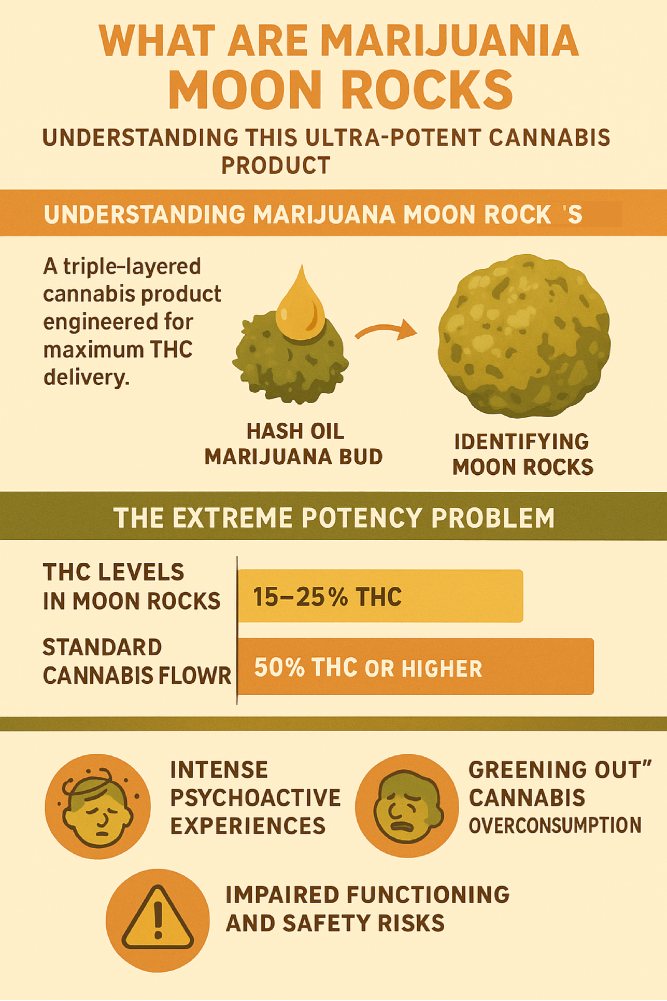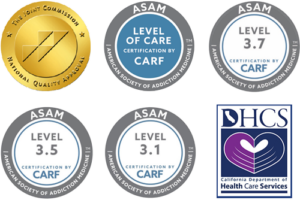What Are Marijuana Moon Rocks?
Published on: November 5, 2025
Understanding This Ultra-Potent Cannabis Product
The cannabis industry continues to evolve, introducing increasingly potent products that push the boundaries of THC concentration. Among these high-potency options, marijuana moon rocks have emerged as one of the most powerful cannabis products available today. For individuals struggling with cannabis use or concerned about a loved one’s consumption of these ultra-strong products, understanding what moon rocks are and their associated risks is crucial.
Understanding Marijuana Moon Rocks
Marijuana moon rocks represent a triple-layered cannabis product that combines multiple forms of marijuana into a single, extremely potent nugget. Unlike standard cannabis flower, moon rocks are engineered for maximum THC delivery through a specific construction process.
How Moon Rocks Are Made
The creation of marijuana moon rocks involves three distinct components working together to create an exceptionally strong product. The process begins with selecting a high-quality cannabis bud, typically from a strain already known for elevated THC content. This foundation bud is then completely saturated with hash oil or cannabis concentrate, which itself contains concentrated cannabinoids far exceeding those found in regular marijuana. Finally, the oil-coated bud is rolled in kief—the crystalline resin glands that naturally accumulate on cannabis flowers and contain the plant’s highest concentration of THC and other cannabinoids.
This layered construction method results in a product where every component contributes additional THC, creating a cumulative effect that far surpasses traditional cannabis consumption methods.
Identifying Moon Rocks
Marijuana moon rocks have a distinctive appearance that sets them apart from regular cannabis buds. They typically appear as dense, compact nuggets with an irregular, rocky texture that inspired their astronomical name. The exterior coating of kief gives them a frosted, almost dusty appearance, while the hash oil beneath creates a notably sticky consistency. Colors can vary depending on the strains used, but they often display a golden or amber hue from the concentrated oils, contrasted with the lighter coloring of the kief coating.
The Extreme Potency Problem
The primary concern with marijuana moon rocks lies in their extraordinarily high THC concentration, which creates significant risks for users—particularly those unprepared for such intensity.
THC Levels in Moon Rocks
Standard cannabis flower typically contains between 15-25% THC, which already represents a significant increase from marijuana available decades ago. By contrast, marijuana moon rocks can contain 50% THC or higher, with some products reaching even more extreme concentrations. This represents double or triple the potency of already-strong cannabis strains, making moon rocks among the most powerful marijuana products available through legal and illegal channels.
This extreme potency fundamentally changes the user experience and risk profile compared to traditional cannabis consumption.
Why Potency Matters
Higher THC concentrations don’t simply create stronger effects—they introduce qualitatively different risks and experiences. The Substance Abuse and Mental Health Services Administration (SAMHSA) has documented how high-potency cannabis products correlate with increased adverse reactions, greater impairment, and higher addiction potential.
When THC levels exceed what the body’s endocannabinoid system can readily process, users may experience overwhelming psychoactive effects that cross the line from recreational use into medical emergency territory.
Short-Term Effects and Immediate Risks
Consuming marijuana moon rocks produces intense immediate effects that can be disorienting or dangerous, especially for those with lower tolerance or those unaware of what they’ve consumed.
Intense Psychoactive Experiences
The high THC concentration in moon rocks creates powerful psychoactive effects that can include extreme euphoria, severe time distortion, profound cognitive impairment, intense sensory alterations, and in some cases, frightening hallucinations or delusions. These effects typically manifest more quickly and intensely than with standard cannabis, sometimes catching users off-guard even when they believe they’re prepared for a strong experience.
Greening Out: Cannabis Overconsumption
“Greening out” refers to the constellation of unpleasant symptoms that occur when someone consumes more THC than their body can comfortably process. With marijuana moon rocks, the risk of greening out increases dramatically due to the concentrated THC content.
Symptoms of greening out include severe nausea and vomiting, extreme dizziness and disorientation, rapid heart rate and chest discomfort, intense anxiety or panic attacks, profuse sweating and chills, pale complexion, and in severe cases, loss of consciousness. While cannabis overdose is rarely life-threatening in otherwise healthy individuals, greening out can be an extremely distressing experience that may require medical attention, particularly when cardiovascular symptoms become pronounced.
Impaired Functioning and Safety Risks
Moon rocks’ extreme potency creates significant impairment of cognitive and motor functions. This impairment affects reaction time, decision-making abilities, coordination and balance, attention and focus, and judgment regarding risk assessment. These effects make operating vehicles or machinery extremely dangerous and can persist for many hours after consumption, far longer than users typically anticipate.
Long-Term Health Consequences
Regular use of high-potency cannabis products like moon rocks carries substantial long-term health risks that extend beyond the immediate effects.
Respiratory System Damage
When smoked, marijuana moon rocks expose the respiratory system to concentrated cannabinoids and combustion byproducts. The American Lung Association notes that smoking cannabis can cause chronic bronchitis, lung inflammation, increased risk of respiratory infections, and potential long-term damage to lung tissue. The sticky, resin-rich nature of moon rocks produces particularly harsh smoke that may intensify these respiratory effects.
Cardiovascular Concerns
THC consumption, especially at high concentrations, affects cardiovascular function in ways that can be particularly dangerous for individuals with existing heart conditions. The American Heart Association identifies increased heart rate (tachycardia), elevated blood pressure in some users, increased risk of heart attack, particularly in the hour after consumption, and potential for irregular heart rhythms. For individuals with underlying cardiovascular disease, these effects can trigger serious medical emergencies.
Mental Health Impact
The relationship between high-potency cannabis use and mental health problems represents one of the most concerning aspects of moon rocks consumption. Research published in The Lancet Psychiatry has established connections between high-potency cannabis products and increased risk of psychotic disorders, including schizophrenia, exacerbation of existing anxiety and depression, potential triggering of bipolar episodes in susceptible individuals, and cognitive impairments that may persist even after stopping use.
Young people and those with family histories of mental illness face particularly elevated risks when using high-potency products like moon rocks.
Cognitive Function and Brain Development
Studies examining the neurological impact of cannabis reveal that regular use of high-potency products can affect memory formation and recall, attention span and concentration, executive function and decision-making, and learning capacity. These effects appear particularly pronounced when high-potency cannabis use begins during adolescence or young adulthood, when the brain is still developing.
Cannabis Use Disorder and Addiction Potential
Contrary to outdated beliefs that marijuana is non-addictive, modern research clearly establishes that cannabis use disorder is a real and increasingly common condition, particularly with today’s high-potency products.
Understanding Cannabis Dependence
The National Institute on Drug Abuse (NIDA) reports that approximately 9% of cannabis users will develop dependence, with rates increasing to about 17% among those who start using in adolescence and 25-50% among daily users. High-potency products like moon rocks may accelerate the development of dependence due to their extreme THC concentrations.
Cannabis use disorder develops when the brain adapts to large amounts of THC, reducing production of and sensitivity to its own endocannabinoid neurotransmitters. This adaptation leads to tolerance (requiring more substance to achieve the same effects) and withdrawal symptoms when use stops.
Signs of Cannabis Addiction
Cannabis use disorder manifests through various behavioral and physical indicators, including using larger amounts or for longer periods than intended, unsuccessful attempts to cut down or control use, spending significant time obtaining, using, or recovering from cannabis, craving or strong urges to use cannabis, continued use despite negative consequences in relationships, work, or school, giving up important activities in favor of cannabis use, using cannabis in physically hazardous situations, and continued use despite knowing it’s causing or worsening physical or psychological problems.
When these patterns emerge, particularly in relation to high-potency products like moon rocks, professional intervention often becomes necessary.
Withdrawal and Recovery Challenges
When someone dependent on high-potency cannabis stops using, they typically experience withdrawal symptoms that can include irritability and mood changes, sleep difficulties and vivid dreams, decreased appetite, restlessness and anxiety, physical discomfort, and intense cravings. These symptoms typically peak within the first week of abstinence and may persist for several weeks, making unsupported cessation attempts difficult.
Specialized Treatment for Cannabis Addiction
At Journey Hillside, we recognize that cannabis use disorder, particularly involving high-potency products like moon rocks, requires comprehensive, evidence-based treatment tailored to each individual’s unique circumstances.
Our Approach to Cannabis Addiction Treatment
Our addiction treatment programs address not only the physical aspects of cannabis dependence but also the psychological, social, and environmental factors that contribute to continued use. We offer multiple levels of care to meet clients where they are in their recovery journey, including medically supervised detoxification to manage withdrawal symptoms safely, residential treatment providing immersive, structured support during early recovery, partial hospitalization programs (PHP) offering intensive daytime treatment, intensive outpatient programs (IOP) allowing clients to maintain work or school commitments, and continuing care planning to support long-term sobriety.
Evidence-Based Therapeutic Interventions
Our clinical team utilizes proven therapeutic approaches specifically effective for substance use disorders, including cognitive-behavioral therapy (CBT) to identify and change thought patterns supporting drug use, motivational enhancement therapy to build internal motivation for change, contingency management providing tangible reinforcement for abstinence, family therapy addressing relationship dynamics and building support systems, and dual diagnosis treatment for co-occurring mental health conditions that often accompany cannabis addiction.
Why Professional Treatment Matters
Many individuals struggling with cannabis use disorder attempt to quit on their own, only to find themselves returning to use during moments of stress or when withdrawal symptoms become overwhelming. Professional treatment provides structured support during this vulnerable period, evidence-based strategies proven to support long-term recovery, medical monitoring to ensure safety during withdrawal, mental health support to address underlying issues, peer connection with others facing similar challenges, and relapse prevention skills to maintain sobriety after treatment ends.
Taking the First Step Toward Recovery
If you or someone you love is struggling with marijuana moon rocks or any form of cannabis use disorder, help is available. The transition from problematic cannabis use to lasting recovery is possible with proper support and treatment.
At Journey Hillside in Tarzana, California, our compassionate team understands the unique challenges of cannabis addiction in the age of ultra-potent products. We’ve helped countless individuals break free from dependence and build healthier, more fulfilling lives in recovery.
Don’t let cannabis control your life any longer. Call Journey Hillside today at (877) 414-1024 to speak with an admissions counselor about our substance abuse treatment programs. We offer complimentary insurance verification and can often arrange admission within 24 hours. Your journey to recovery starts with a single call.
References:
- National Academies of Sciences, Engineering, and Medicine. (2017). The Health Effects of Cannabis and Cannabinoids. https://www.ncbi.nlm.nih.gov/books/NBK425767/
- Substance Abuse and Mental Health Services Administration. (2023). Know the Risks of Marijuana. https://www.samhsa.gov/marijuana
- National Institute on Drug Abuse. (2023). Cannabis (Marijuana) Research Report. https://www.drugabuse.gov/publications/research-reports/marijuana
- Di Forti, M., et al. (2019). The contribution of cannabis use to variation in the incidence of psychotic disorder across Europe. The Lancet Psychiatry, 6(5), 427-436. https://www.ncbi.nlm.nih.gov/pmc/articles/PMC7442038/
- American Heart Association. (2020). Marijuana and Heart Health: What You Need to Know. https://www.heart.org/
- American Lung Association. (2023). Marijuana and Lung Health. https://www.lung.org/quit-smoking/smoking-facts/health-effects/marijuana-and-lung-health





